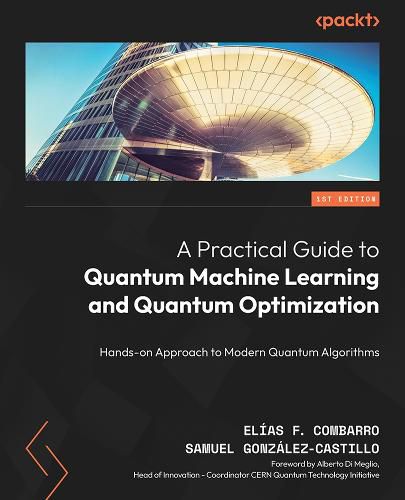Readings Newsletter
Become a Readings Member to make your shopping experience even easier.
Sign in or sign up for free!
You’re not far away from qualifying for FREE standard shipping within Australia
You’ve qualified for FREE standard shipping within Australia
The cart is loading…






This title is printed to order. This book may have been self-published. If so, we cannot guarantee the quality of the content. In the main most books will have gone through the editing process however some may not. We therefore suggest that you be aware of this before ordering this book. If in doubt check either the author or publisher’s details as we are unable to accept any returns unless they are faulty. Please contact us if you have any questions.
Work with fully explained algorithms and ready-to-use examples that can be run on quantum simulators and actual quantum computers with this comprehensive guideKey Features
Get a solid grasp of the principles behind quantum algorithms and optimization with minimal mathematical prerequisites Learn the process of implementing the algorithms on simulators and actual quantum computers Solve real-world problems using practical examples of methods
Book DescriptionThis book provides deep coverage of modern quantum algorithms that can be used to solve real-world problems. You'll be introduced to quantum computing using a hands-on approach with minimal prerequisites. You'll discover many algorithms, tools, and methods to model optimization problems with the QUBO and Ising formalisms, and you will find out how to solve optimization problems with quantum annealing, QAOA, Grover Adaptive Search (GAS), and VQE. This book also shows you how to train quantum machine learning models, such as quantum support vector machines, quantum neural networks, and quantum generative adversarial networks. The book takes a straightforward path to help you learn about quantum algorithms, illustrating them with code that's ready to be run on quantum simulators and actual quantum computers. You'll also learn how to utilize programming frameworks such as IBM's Qiskit, Xanadu's PennyLane, and D-Wave's Leap. Through reading this book, you will not only build a solid foundation of the fundamentals of quantum computing, but you will also become familiar with a wide variety of modern quantum algorithms. Moreover, this book will give you the programming skills that will enable you to start applying quantum methods to solve practical problems right away.What you will learn
Review the basics of quantum computing Gain a solid understanding of modern quantum algorithms Understand how to formulate optimization problems with QUBO Solve optimization problems with quantum annealing, QAOA, GAS, and VQE Find out how to create quantum machine learning models Explore how quantum support vector machines and quantum neural networks work using Qiskit and PennyLane Discover how to implement hybrid architectures using Qiskit and PennyLane and its PyTorch interface
Who this book is forThis book is for professionals from a wide variety of backgrounds, including computer scientists and programmers, engineers, physicists, chemists, and mathematicians. Basic knowledge of linear algebra and some programming skills (for instance, in Python) are assumed, although all mathematical prerequisites will be covered in the appendices.
$9.00 standard shipping within Australia
FREE standard shipping within Australia for orders over $100.00
Express & International shipping calculated at checkout
This title is printed to order. This book may have been self-published. If so, we cannot guarantee the quality of the content. In the main most books will have gone through the editing process however some may not. We therefore suggest that you be aware of this before ordering this book. If in doubt check either the author or publisher’s details as we are unable to accept any returns unless they are faulty. Please contact us if you have any questions.
Work with fully explained algorithms and ready-to-use examples that can be run on quantum simulators and actual quantum computers with this comprehensive guideKey Features
Get a solid grasp of the principles behind quantum algorithms and optimization with minimal mathematical prerequisites Learn the process of implementing the algorithms on simulators and actual quantum computers Solve real-world problems using practical examples of methods
Book DescriptionThis book provides deep coverage of modern quantum algorithms that can be used to solve real-world problems. You'll be introduced to quantum computing using a hands-on approach with minimal prerequisites. You'll discover many algorithms, tools, and methods to model optimization problems with the QUBO and Ising formalisms, and you will find out how to solve optimization problems with quantum annealing, QAOA, Grover Adaptive Search (GAS), and VQE. This book also shows you how to train quantum machine learning models, such as quantum support vector machines, quantum neural networks, and quantum generative adversarial networks. The book takes a straightforward path to help you learn about quantum algorithms, illustrating them with code that's ready to be run on quantum simulators and actual quantum computers. You'll also learn how to utilize programming frameworks such as IBM's Qiskit, Xanadu's PennyLane, and D-Wave's Leap. Through reading this book, you will not only build a solid foundation of the fundamentals of quantum computing, but you will also become familiar with a wide variety of modern quantum algorithms. Moreover, this book will give you the programming skills that will enable you to start applying quantum methods to solve practical problems right away.What you will learn
Review the basics of quantum computing Gain a solid understanding of modern quantum algorithms Understand how to formulate optimization problems with QUBO Solve optimization problems with quantum annealing, QAOA, GAS, and VQE Find out how to create quantum machine learning models Explore how quantum support vector machines and quantum neural networks work using Qiskit and PennyLane Discover how to implement hybrid architectures using Qiskit and PennyLane and its PyTorch interface
Who this book is forThis book is for professionals from a wide variety of backgrounds, including computer scientists and programmers, engineers, physicists, chemists, and mathematicians. Basic knowledge of linear algebra and some programming skills (for instance, in Python) are assumed, although all mathematical prerequisites will be covered in the appendices.